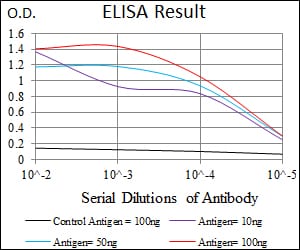GATA6 Primary Antibody
Item Information
Catalog #
Size
Price
Description
This gene is a member of a small family of zinc finger transcription factors that play an important role in the regulation of cellular differentiation and organogenesis during vertebrate development. This gene is expressed during early embryogenesis and localizes to endo- and mesodermally derived cells during later embryogenesis and thereby plays an important role in gut, lung, and heart development. Mutations in this gene are associated with several congenital defects.
Product Overview
Entrez GenelD
2627
Aliases
GATA6
Clone#
2F10G3
Host / Isotype
Mouse / IgG1
Species Reactivity
Human
Immunogen
Purified recombinant fragment of human GATA6 (AA: 491-557) expressed in E. Coli.
Formulation
Purified antibody in PBS with 0.05% sodium azide
Storage
Store at 4°C short term. Aliquot and store at -20°C long term. Avoid freeze/thaw cycles.
Product Applications
WB (Western Blot)
1/500 - 1/2000
FCM (Flow Cytometry)
1/200 - 1/400
ELISA
1/10000
References
1. BMC Cancer. 2012 Jun 6;12:218.
2. Neonatology. 2011;99(3):231-40.
2. Neonatology. 2011;99(3):231-40.
Product Image
Western Blot

Figure 1: Western blot analysis using GATA6 mAb against human GATA6 recombinant protein. (Expected MW is 32.3 kDa)
Western Blot

Figure 2: Western blot analysis using GATA6 mAb against HEK293 (1) and GATA6 (AA: 491-557)-hIgGFc transfected HEK293 (2) cell lysate.
Flow cytometric

Figure 4: Flow cytometric analysis of HEK293 cells using GATA6 mouse mAb (green) and negative control (red).
Elisa

Black line: Control Antigen (100 ng); Purple line: Antigen(10ng); Blue line: Antigen (50 ng); Red line: Antigen (100 ng);
For Research Use Only. Not for use in diagnostic procedures.

